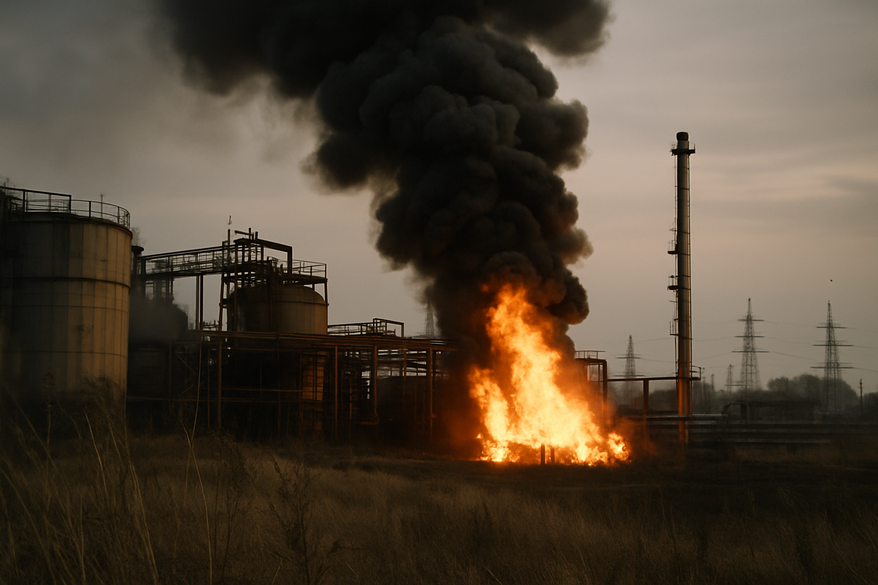Strategic overview: oil and gas targets in the Ukraine conflict
As a manufacturer serving the oil and gas sector, Teknologam Sdn Bhd watches infrastructure risks closely. The pattern of attacks and their operational fallout in the Russia–Ukraine war affect procurement, maintenance, and safety planning. We compile verified reports and technical observations to help partners understand which systems face the greatest exposure. This article distills recent developments, an operational list of affected facility types, and practical responses for industry stakeholders.
Key takeaways:
- Frontline change: Attacks have concentrated on refining, storage, and pipeline nodes, altering regional fuel flows.
- Technical insight: Damage patterns show repeat targeting of downstream pressure-control and metering installations.
- Business outcome: Companies must revise contingency inventories and strengthen remote-monitoring redundancy.
Current context: why energy infrastructure matters now
The Russia–Ukraine war has shifted from front-line combat to deliberate strikes on economic infrastructure. Energy sites are strategic targets because damage there amplifies disruption across civilian and military logistics. For global suppliers and manufacturers, the sequence of attacks increases urgency on component resilience, spare‑parts availability, and repair-readiness.
Key points:
- Strategic sites hit include refineries, storage depots, compressor stations, and export terminals.
- Secondary damage often disables ancillary control buildings and telemetry equipment.
- Rebuilding timelines vary widely: weeks for small tanks, months for mid-scale facilities, and years for complex refineries.
Compiled observations: russia strikes ukraine oil gas facilities list (verified patterns)
Open-source monitoring and official briefings produce a practical inventory of facility types and functional failures repeatedly observed. We avoid speculative site naming and focus on categories and failure modes to help engineers plan mitigations.
"Our emphasis is on functional exposure: which systems fail, not only which sites are hit." — Engineering lead, Teknologam Sdn Bhd
Common damage modes and observed failures:
- Blast shear to piping and flange assemblies.
- Fire-induced tank roof collapse and secondary tank fires.
- Electromagnetic and physical damage to control cabinets and telemetry radios.
- Metering and pressure-regulation stations suffering rupture, valve failures, or loss of control.
- Export terminals impacted by both structural strikes and targeted equipment sabotage.
Key insight: Prioritize resilient valves, flanges, and remote‑operable actuators that enable isolated operation when telemetry fails.
Operational impacts: supply chain and maintenance implications
Attacks reshape how operators schedule maintenance and manage stock. Lead times for specialty valves, high-pressure seals, and instrumentation often exceed normal forecasts after an incident. Logistics corridors become constrained, and alternative routing raises transportation costs and lead times.
Operational implications:
- Redundancy needs increase for critical-path items like turbine seals and pressure‑relief valves.
- On-site inventory strategies should shift toward modular skids and interchangeable components.
- Remote diagnostics must be hardened, and offline control modes tested regularly.
These changes force manufacturers and service providers to revise procurement contracts and allocate working capital for higher on-hand inventories. Insurance terms can shift too, requiring clearer loss-prevention documentation and traceable maintenance records.
Safety, compliance, and technical mitigation
Operators must balance immediate repairs with long-term resiliency upgrades. Structural reinforcement, passive fire protection, and blast-resistant enclosures reduce vulnerability. Equally important are electrical isolation schemes and hardened SCADA/ICS segments.
Recommended technical measures:
- Install local manual isolation points for key pipeline and product-transfer segments.
- Fit inline emergency shutdown (ESD) valves with independent power and dedicated closure logic.
- Harden telemetry by multiplicity: cellular, satellite, and physical dial-back systems; ensure deterministic failover and local control capability.
- Protect control cabinets and communication nodes with blast- and fire-resistant enclosures and redundant power feeds.
- Adopt documented cybersecurity and ICS hardening practices to reduce risk from both physical and cyber disruption: see the NIST guidance for Industrial Control Systems for practical controls and architectures. NIST SP 800-82 Rev. 2: Guide to Industrial Control Systems Security
Regulatory compliance remains dynamic. Export and transit restrictions, sanctions, and inspection regimes change with the conflict. Technical teams should maintain traceable records of parts provenance and maintenance actions to satisfy auditors and insurers.
Practical recommendations for manufacturers and operators
Teknologam Sdn Bhd recommends the following actions to preserve continuity and safety:
- Conduct a rapid functional risk assessment of all upstream and downstream nodes, focusing on single-point failures and remote‑operability gaps.
- Reclassify critical spares and accelerate procurement for items with long lead times.
- Increase modularization of field equipment to allow rapid swap-out in austere or degraded-communications conditions.
- Standardize connectors, manifold interfaces, and control logic to maximize interchangeability across sites.
- Strengthen supplier agreements to include emergency lead-time clauses and localized stocking where feasible.
"We advise partners to treat resilience as a product feature, not only a risk mitigation step." — Operations manager, Teknologam Sdn Bhd
Also monitor official technical advisories and incident bulletins from industry and government sources to stay current; a good starting point for industrial-control and infrastructure advisories is the Cybersecurity and Infrastructure Security Agency’s ICS resources. CISA Industrial Control Systems (ICS) resources
Use layered sources: official briefings, satellite-imagery analysts, and sector-specific advisories to validate observations and update mitigation plans.
Looking forward: scenario planning and long-term resilience
The continuing pattern of strikes will influence investment and design decisions across the basin. Expect a stronger market for hardened equipment, rapid‑deploy skids, and diagnostic packages that operate with intermittent communications. Suppliers who certify parts for rough-field reparability and interchangeability will find rising demand.
Scenario planning guidance:
- Scenario A: Short-term disruption with rapid repairs — emphasize logistics flexibility and rapid transport options.
- Scenario B: Prolonged targeting of nodes — emphasize modular systems, local stockpiles, and longer-term contracts for repair services.
- Scenario C: Widespread damage and sanctions — emphasize secondary sourcing, substitution planning, and on‑site manufacturing capability where permitted.
Final reflection: Teknologam Sdn Bhd will continue to support clients with resilient component designs, rapid-response inventory options, and engineering guidance tailored to conflict-driven risks. Staying pragmatic, technically focused, and informed by verified reports helps companies maintain operations despite the evolving security landscape.
